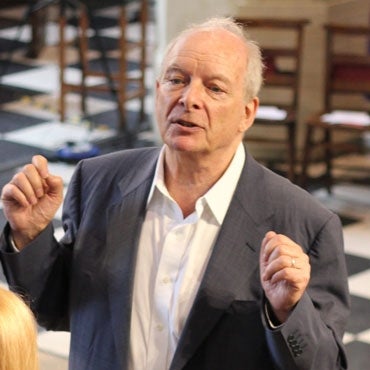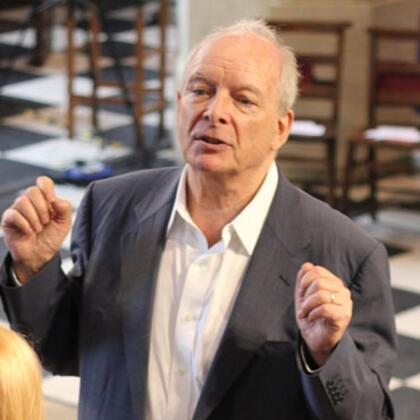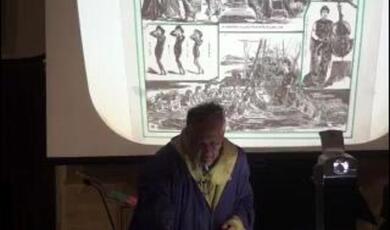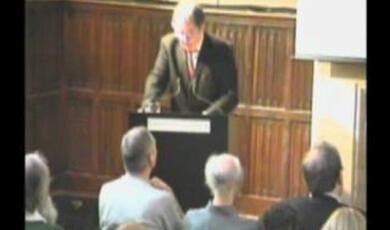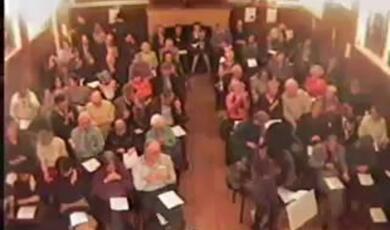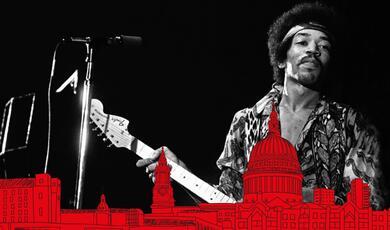14 November 2013
At an Amateur Domestic Evening:
Haydn Symphony no. 104 'London', arr. Salomon
Professor Christopher Hogwood CBE
Good afternoon. This is the second of these lectures dealing with music in a particular context, and you will be glad to know it is more cheerful venue than last time, which was “Music in Prison Camp”, and potentially more cheerful than our next December venue, which is going to be the practice room or the teaching studio, which could be also rather oppressive. It will not be, but it does not sound immediately so appealing.
So, I thought, for today, we would take a much more open atmosphere and look at the question of what went on with the major music at the end of the eighteenth century, as far as the largest public was concerned in Europe, and that would be the domestic public. We are very used to construing music history in terms of the biggest concert halls and the great premieres and the very aristocratically dominated concert venues all over Europe, or the opera house. I think we tend to forget that, in that period, pre-radio, pre-recordings, people well away from a capital city or a major musical venue still became very familiar very quickly with contemporary music. In fact, I think they probably score quite a bit higher in the eighteenth century for being aware of music that was written last year than most of us are of music that was written last year. With all the advantages of recordings and radio, we tend to look back to a music of a century or two centuries ago. This would have struck an eighteenth century educated amateur as a rather strange thing. Nobody, at the end of the eighteenth century, would be taking very much interest in music of the sixteenth century. You would have to be a definite antiquarian to place your musical tastes so far out of the normal fashionable arena, which meant people were kept well informed, by newspaper, of what was going on in major musical centres, and they wanted to know more and more about it.
From that situation, there grew a tradition of house music and, along with it, the industry of making arrangements of music that was rather too grand to fit into your normal domestic music room. So, we have to imagine a situation. We might be out in the counties somewhere, fully aware - this is the end of the eighteenth century, in Georgian times - that great things were happening in London. Joseph Haydn had been coming to London for two major concert series in the 1790s. Everybody talked about this. Haydn was the greatest composer in the world, in the known world, at that time, and also the most published, and, for the sake of those people who could not have access to the concerts in London or Paris or an aristocratic palace in Hungary or Austria, they were able to perform what Haydn had composed last year this year. They could, if they ran to a local symphony orchestra, of course, play the original version of a symphony. This was quite difficult to manage. Not every place had the resources for a full symphony orchestra. They might have had a music club of a few people who could play and sing.
More likely, they would have had the usual domestic arrangement of a chamber music group, a string quartet maybe, surely a keyboard instrument, and the favourite instrument of the musical aristocrats and amateurs, which was the flute. The reason for the flute being so popular of course was that you looked nice when you played the flute, the same as ladies discovered later in the century, the nineteenth century, you looked good when you played the harp. So, these were profitable instruments to pick up. You did not look so good if you played the trumpet and went red in the face. You did not look very good if you had to purse your lips and play the oboe. There was a certain domestic social propriety about this that lent in the direction of the very useful all-purpose flute, the stringed instruments of the string quartet – that should not be difficult to muster in a country place, and, inevitably, a keyboard if you had any musical sense in your music room, rather like the keyboard here, a late-eighteenth century forte piano.
The home music that you made of course was homemade, but it was definitely not home-limited. I think we only have to go back a few generations – I am thinking as far as my grandparents, for example, which is not exactly eighteenth century – this idea that you got to know standard classical works by playing them yourselves in an arranged form. I certainly played Beethoven symphonies and Brahms symphonies, as the bottom two hands of a piano duet. This was a hands-on experience. You were not getting the music in exactly the sonorities that the composer had intended, but you were getting all the musical material that he offered, and you were getting it in such a form that you could explore it yourself, stop, go back, examine it, get it right second time, look at what Beethoven or Brahms was doing. The same went for operas of course, which were arranged for every possible combination. Some were a little weird, I have to say. Beethoven’s ninth Symphony arranged for two flutes is stretching the imagination, and so is Rigoletto arranged for guitar! But you have to be lenient – they tried to make the biggest of the musical market available, and there were some very well-calculated arrangements, often by the composer themselves.
Brahms, for example, arranged most of his big orchestral music himself for four hands at the piano. He found it no disgrace. In fact, he had extra ideas available when he had abandoned the idea of orchestral colouring and could reduce it to four hands at the keyboard and he used to perform in that format. Interestingly, he often used to play piano duets with Joachim, who you think of as the greatest violinist of Brahms’ time, but he was also a pretty fair keyboard player.
I think the art of arranging music has now become a little bit debased as an idea. This is probably the fault of the pop world and the easy, available, most basic technique arrangement of popular music. It is a pity, I think, that this music factory idea has influenced which once was a great trade.
We have to be careful I think when we talk about arrangements suitable for domestic use, distinguish between an arrangement that is made long after the event. I think, if you take a Mozart symphony and have it arranged at the end of the nineteenth century by a virtuoso pianist, you will get probably some very dramatic keyboard music, but you will not get a stylistic link back to the language of Mozart. On the other hand, an arrangement of Mozart made by himself, or by his immediate contemporaries and friends, will speak to you of the same musical idiom but in a slightly modified instrumental language. I think it is different from what we take now to be our obvious entry to keeping up with the musical world, which is sitting down and listening to a recording. It is true that when you switch on your hi-fi and listen to a Brahms symphony or Bartok or Ligeti, you are getting the actual sounds that the composer included in the full version, but you are taking them in a passive form. You are sitting there and receiving them. The added advantage, I think, to the eighteenth and nineteenth century interest in arrangements of everything and anything was that you were actively involved in them. I know that, if you play the bottom two hands of a Beethoven symphony or a Brahms symphony, in a keyboard arrangement, you are very aware of what the viola is doing in that context because you are playing the viola’s part, and looking at it, a lot of things come to light which are not always immediately apparent to the ear. When you are listening to a hi-fi recording of a Brahms symphony, I defy you to follow the viola part throughout – quite impossible. It would upset the balance of the whole show, and only the viola player, on the whole, knows what he played or what he was supposed to play. So, we are into a different attitude to the performance of music as something that involves you rather than as something that you sit outside and observe.
I am focusing on Haydn for this sample today, simply because I think we tend to forget how recently it has come about that Haydn has become a common symphonic name. It was not so long ago, I remember, Bernard Levin wrote a wonderful piece in the Times, if you remember, the columnist, Bernard Levin, when it was halfway through the production of the Dorati full set of Haydn symphonies, the first time Haydn symphonies had been completely recorded, and this was the middle of the last century, not so far back, and Bernard Levin wrote a wonderful, enthusiastic piece, the first really enthusiastic piece I think I had ever read in a normal newspaper, exclaiming on 104 reasons why he loved Haydn, and that was the 104 Symphony, which, mostly, people had been unaware of. I did a little check the other day to see how many of these 104 symphonies had actually been performed in our major concert venues. You would think, over the last umpteen years, we would have heard them all somewhere. It is not true – neither the Albert Hall, nor the Barbican, nor the Southbank have performed every one of the Haydn symphonies. I could give them a long list, of twenty or thirty, which are still waiting in the wings to be heard. So, this was a major event that Decca and Dorati were doing, presenting people, for the first time, with actually more than 104 symphonies in their orchestral form, to be absorbed passively as the audience.
I would like to introduce us to the way that the eighteenth century would have come across this repertoire, and that is in specific arrangements made in a format that was designed to fit the complexities of the orchestral writing that Haydn had put down for the London symphonies.
Here is a little description from Samuel Wesley, who gave a long series of lectures on music in London, very similar to Gresham, but not Gresham lectures, unfortunately, but he took various musical topics each year. This was Samuel Wesley, 1826, lecturing, and in his lecture on arrangements in general, he ended by giving examples, and, having performed, he said, “Certain invaluable works, originally constructed for a full band, that have been very ingeniously contracted for the convenient accommodation of small musical parties,” and among them, he says, “Let me instance twelve delectable symphonies of Haydn, which have been reduced from the score with extraordinary ingenuity and accurate judgement by the late accomplished and energetic master of his art, John Peter Salomon, and nicely adapted for two violins, viola, cello, flute and a supporting accompaniment on the piano forte.”
This is the scene you see before you: the piano forte, the string quartet, and the flute.
[Audience applause]
Haydn’s attitude to music, I think, I would classify as more one of honesty and humanity and genius and without the usual grand complexes of attitude and so on. He was intellectual, as opposed to Mozart, who had attitude and was very, very smart. But I think we are only gradually realising quite what complexity lies behind Haydn’s, I will not say “simple sounding music” but music that presents itself to you in large-scale or small-scale. To my mind, it is a question of TV cookery – you know the types of cookery shows you have where you are taken through every stage from raw ingredients, assembly, cooking, and “here is one I prepared two hours earlier” sort of thing, but, unit by unit, implying that you could actually do it yourself. In fact, I think we are told that only point-something percent of people who watch cookery programmes actually cook, but we get the idea that we know we could if we had to, and we can also see the artistry and skill that goes into the building up of a meal. That is Haydn – he is the TV cook, as opposed, I think, to Mozart, who arrives from the kitchen with it fully finished and decorated, saying, “Look at this, folks, and admire,” you know, do not look behind the scenes. Haydn is always trying to draw you into his processes.
Some of the processes are complicated, and music analysts have a great time pulling Haydn to pieces. One thing that has surprised me very much with scientists who have studied 104 symphonies of Haydn is that he appears to have used very specific formulas for how to calculate the architecture of each symphony or groups of symphonies, that is, the overall plan, the numeric proportion, harmonic proportion, too complicated to explain in general, but in fact, when the symphonies are analysed, you discover that there is a little formula applicable to one, two or three symphonies written in the same year or so, that formula then abandoned, never used again, another formula later. This is to do with all the variables that are available to you in the symphony, like what key you are in, how you modulate higher, how you modulate downwards, to the sharp side, to the flat side. It is a question of harmonic progressions and there are many, many surprising moves in Haydn. If you map these out on a graph, you get a picture. The picture has salient features. You map out all the symphonies and you discover that symphonies seven, eight and nine all have the same salient outline – it never occurs again. A little later on, you have a different outline, with a different experience, again, used more than once by Haydn. It makes you realise I think that the apparent innocence of this writing is not quite as lacking in calculation as we might be led to believe. It is not making demands on you but it is making great demands on Haydn and he is calculating these shapes, these moves, according to some formulae. It is still ongoing research, so we are gradually getting to peel back the layers and the levels of Haydn’s intellect and discover these things.
There are other features of Haydn’s music which always gets commented on. For example, he writes an irregular number of bars in a theme. Instead of a four-bar theme and an eight-bar theme or a sixteen-bar theme, you frequently find in Haydn fives or sevens or something like this. Everybody thinks this is very strange, but, just imagine, if you are sitting all day in a major palace in Eastern Europe, in Hungary, in Esterhazy, looking out of your window at a façade in front of you, you will have a major doorway, as here, and, on either side, lesser doorways and windows and windows, so, in any stretch, you will have one, one-two, one-two, there is a five-bar phrase. Once you have accepted that one of the analogies for music could be architecture, the same as it could be poetry and stanzas and rhyming arrangements, you begin to look more carefully I think at bar number three, because you realise bar number three represents that doorway. One and two are the windows advancing on it; four and five are the windows diminishing from it. So, you get, immediately, an architectural implication in the musical layout.
Even numbers come into this, and we can show you, just by taking the opening of this symphony, the last symphony that Haydn wrote for London, 104, that he was very much a god of small things – he works in the smallest units, and units that you can hear. You do not have to be a genius with a computer or even literate in music notation to hear what is going on.
So, if we tune-up now, in the way they tuned-up in the eighteenth century, they started from D and they did a lot of D-D-D-D-D, and then, eventually, A would come, like this…
[Music plays]
That interval is exactly what opens the last of his symphonies. You would think it was something that ought to have got used up early on, before number 104, because it is such a basic sound to everybody coming to an orchestral concert. That is what every audience hears today – well, not exactly, because you start from A, but every eighteenth century audience heard everywhere before every symphony was performed. It is nice that Haydn reserves this idea for his very last symphony, that he will use the basic elements of violin tuning, [sings] one-one-five, and then repeats it [sings] tum-pum-pum, he goes – that is only a fourth, so here is a little difference. The other interval, he uses to counterbalance that very blatant interval, one-one-five, is [sings] one-one-two…. Just play the opening of the symphony, without going very much further then, just to show us… This is one-one-five…
[Music plays]
And then comes the smaller interval…
[Music plays]
And so on… So you see, he has reduced it, one-on-five [singing] – the entire symphony is made up from an accentuation on an interest on those two intervals. It is very ingenious.
Mozart scarcely ever – in fact, I think one can say never – ran a policy or a formula in his symphonies throughout all four movements. There would be very ingenious constructs in one movement, and there would be very ingenious and beautiful things in the second movement, but, as in many Mozart symphonies, you might then have an adjustment of the second movement, like the Paris Symphony, where you have an alternative. It does not matter at all because there is no underlying formula that runs. Haydn does not give you alternatives because he goes on, and we shall see, when we come to other movements, that his very limited, self-limited repertoire, the very basic ingredients he’s laying out for you in this musical cookery demonstration, as first of all, the fifth and then the second. It comes also – just play the beginning of the allegro of this first movement and you will see the same principle going with it, and even emphasised.
[Music plays]
There is the fifth – [sings] – and a lot of scale [wise], which is… It all makes great sense. There are many, many other constructs going on under this – do not worry about it, and also very enlivening orchestration. I think you will find, even if you are familiar with this symphony in its full orchestral dress, how ingenious Salomon had been. This was Haydn’s impresario, who decided to make arrangements of these pieces, as Wesley pointed out. First of all, he made arrangements for a piano trio, that is, where the piano plays everything, and one violin and cello just nod along – very boring for the strings. Obviously, he was a great violinist himself. He wanted to get more of the music in and for more people to have fun. I think you will be hard pushed to realise that the flute represents, both a violin and a flute and an oboe, sometimes a second oboe, all sorts! We will come to a moment later on where two strings over here represent two French horns, for example. The music is there, the notes are there, it is just the sonorities have gone AWOL and you get all the musical material in a different set of colours. It is really called a symphony quinteto. You might count up and see we have six people, but that is because the piano, as Wesley said, was very much ad libitum, and I suspect what is written out in that piano part is the sort of thing that Haydn himself would have played when he was half-directing the orchestra, with Salomon, in the London premiere of this piece.
Here is the first movement of the symphony…
[Music plays]
[Audience applause]
I think, once one’s ear is attuned to the size of the ensemble, you realise that there is no musical matter missing in the argument. The colours are different. Also, I think it is fair to say nobody is asked to do anything extraordinary. I think everybody has to do a little bit more than they might have to do in the orchestral context because the viola cannot just be the viola. He has to be a second violin or a horn or a bassoon or has to take on a multitude of jobs. So, the parts are more elaborate, but never unidiomatic, which I think is one of the great tricks of good arrangement, and Salomon clearly was a master of adapting this music. The only thing that might be missing from it is sheer bulk, and I think you will find that in the solutions he applies, for instance, to the second movement. He goes on using his formulas of five, the big interval, the fifth, and the little interval, the second, almost exclusively, but his construction of the movement has to follow Haydn’s symphonic idea, which has a very turbulent and stormy middle section before returning to the mood of the opening.
The construction of the tune is interesting in the slow movement because it does adopt, as I say, these formulas that we have been given already quite a lot of in the allegro. Perhaps just play the opening tune of the slow movement, just if we do it very slowly and you will see the intervals as they come… It is second…fifth…
[Music plays]
Then a wide one…second…second…
[Music plays]
And he uses that allocation of the fifth and the second either a minor second or a major second, almost exclusively melodically. I think almost everything else grows out of that all the way through.
One interesting point, I said the strings have to do other jobs than just being the strings. When you get to the end of the movement – just play when you become two horn players…
[Music plays]
Double-stopping on the viola gives you two instruments for the price of one – it is great!
So, here is the slow movement. Now we have got our ears accustomed to this domestic unit, this is the amateur music room learning first-hand music that is absolutely contemporary. These arrangements were published within months, if not a year, after the symphonies were written. Everybody could get to know them, and the bonus is the viola got to know the horn parts as well, which would not have been normally the case in the orchestra.
Here is the slow movement of the same symphony…
[Music plays]
[Audience applause]
I did not previously say anything about the instruments that you see here, other than the forte piano which is a replica of an eighteenth century instrument, but if you have perfect pitch, you will realise that the pitch we are playing at this afternoon is a semitone lower than modern pitch. Classical pitch, official, 4-30, so you are a little bit down. If you feel it is slightly flat to your well-known, four-four-two or whatever symphony orchestras are at nowadays – it goes up every year, four-four-four. I think Vienna and Tel Aviv almost 4-50 nowadays. This is a nice, relaxed lower pitch, [gut strings], you see different bows, different ways of holding the instruments, cello, no spike, held between the knees. Cellists would often be gamba players as well as cellists – it was an adaptable – and they would also bow under-hand and over-hand, so holding the bow underneath or on top, depending whether they were playing chamber music or solo music. The flute, you see, has far fewer keys than a modern flute. This has only…three..? Five? Six keys? That is moving into the industrial age! But still quite a number of open holes, for example, which means you can do clever things with your fingers that you cannot do if you are playing a more mechanised flute, where every hole is covered with a key. On the open instruments, you can make all sorts of nice nuances. I think the sounds that Salomon had in mind for this arrangements would have been these sounds more than the modern chamber music sounds, and it does a service to an arrangement, I think, to try and recapture its original terminology. So, that is the instrumental group.
The remaining movements of the symphony go through the same thematic ideas, these little module arrangements, of fifths and seconds, very easily. There are two minuets. It is interesting that, although Haydn wrote the symphony saying “minuet in trio”, so you had minuet trio and a repeat of the minuet, Salomon goes out of his way and, I do not know why, in some of his arrangements, because he adapted all twelve London symphonies and another dozen earlier symphonies as well for this same, I think, very ingenious combination. He goes out of his way in some of them to label the movements “minuet one” and “minuet two”. Here you have minuet – but in the symphonic version, he calls it “trio”. Minuets were fast. We now know that they were played fast, with all their repeats, so that there would not be this sort of languishing, nor should there really be a languishing when you come to the trio. It is not a trio, it is just another minuet, and the dancers go on at the same speed. You will find all the same hallmarks, of course, of the fifth, but mostly, and particularly, in the trio, everything step-wise, two, two, two, two, seconds, all the way down from his motto theme.
The beginning of the finale is interesting because this is the last symphonic movement that Haydn wrote, other than the concertante movement that came after this one, but this is his last pure symphonic movement. It has a very folksy theme, and if we play it in a folksy way, count the intervals a little bit and you will see – just give the folksy version…
[Music plays]
And it is made even more folksy by a drone – the cello puts down a drone of D…
[Music plays]
So, it is very much a hurdy-gurdy tune. There is debate: is this a tune from Croatia or is it, as they said, a very well-known London tune which was called “Hot-cross buns, hot-cross buns!” take your choice. It has definitely a Slavonic flavour in it, to me, but it also is Haydn’s nicest trick, I think, that he gets you all the way through this symphony before he shows you that the outlines, these two particular intervals that he is using, the fifth and the second, are all contained. If you just play that one again and we just give the notes numbers for it… So it is the second…
[Music plays]
And a second…
[Music plays]
One, one, five, two, one, second, second…
[Music playing]
Fifth, second… It all breaks up into this…the fifth and the second, ingeniously. It may have been his own invention. I would not put it past Haydn to have invented something and then put the word around that it was a Croatian folksong or a fishwives’ song from Billingsgate! It works extremely well though, with the drone underneath, that harnesses it into folk style. Haydn, I think, is, I would say, the only symphonic writer I can think of whom always gets the finale right. Mozart sometimes gets it nearly right, sometimes wonderfully right, but not inevitably right. Haydn, I think, out of 104 symphonies, there is not one symphony where you feel let down by what he does at the last moment, and I think a lot of it is to do with this architectural planning or numerical or mathematical planning that we are only just becoming aware of, that everything was constructed as wheels within wheels, and we have been brought through three movements with this fifth and second being featured without us being told so much. It is very much a subliminal way of dealing with all this and disguising it under other forms of drama. So, in the second minuet, you have it disguised under a dance form, and in the finale, you have it made quite brutally apparent in this… Even if it is soft, it has the atmosphere of quite a raucous tune, and particularly the way it goes up at the end. That little leading upwards by a second is a mathematical clue, but it also fixes it quite firmly I think in an idiom which was not the idiom of the grand concert hall. Possibly, it was not even the idiom of England at all, but it was very attractive to everybody and, incidentally, it sums up the mathematical construction of most of the melodic intervals that he has used in the entire symphony. As I said, it is something that Mozart never attempted, and Haydn, we are only beginning to realise had this compacted, geometric, mathematical idea running through every one of his 104 symphonies.
So, here we have time for a quick minuet, and a second minuet, followed immediately by a finale. If you feel like dancing the minuets, feel free…!
[Music plays]
© Professor Christopher Hogwood, 2013


 Login
Login
